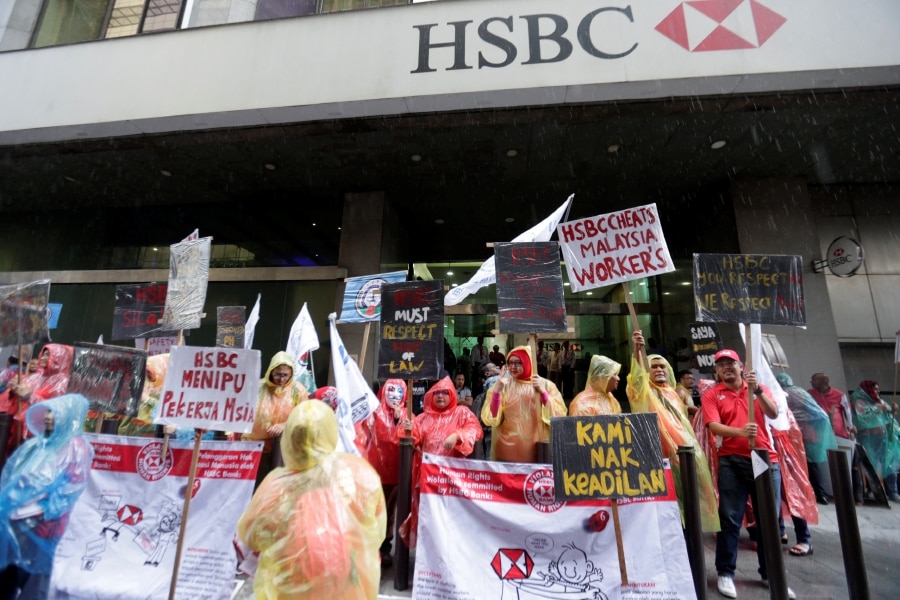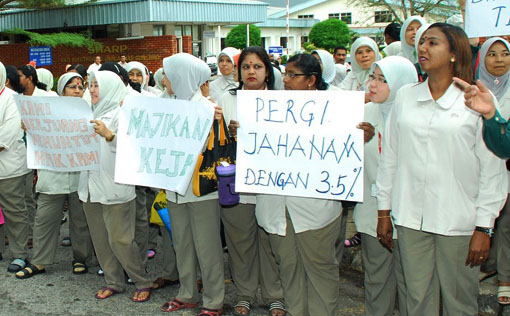Workers in today’s Malaysia have less power than we did back then. Here’s how it happened.

- 282Shares
- Facebook243
- Twitter8
- LinkedIn8
- Email9
- WhatsApp14
Finding a job can be hard these days. And even if you do find one, there’s a chance things can still go wrong. In the past few years, we saw plenty of retrenchments (dismissing workers to save costs), unfair dismissals, discrimination, and most recently, school guards in Kelantan who haven’t been paid since August (two months ago), and even then it was only a half month’s pay.

Are all these legal things for employers to do to their workers? Maybe some are, but they still seem unfair. Some had said that labor laws in Malaysia are so far behind that when we wanted to be part of the Trans-Pacific Partnership Agreement (TPPA, said to be a threat to labor rights itself), we had to first improve our own labor laws to their minimum standards of human and worker rights.
Wahlao. If only there is a way workers could band together and ask for better treatment from their employers or for better laws from the government. The good news is, there is a way, and it’s through something called a trade union. Basically, it’s when a group of workers get together and decide to look out for and protect each other from being treated like slaves by their employers. We’ll talk more about unions later, but so far it sounds like a pretty sweet deal, right?
Now, for the bad news…
As of last year, only 6% of workers in Malaysia are in a trade union

Considering that only 6% of workers in Malaysia are in a trade union as of June this year, you might be wondering what the heck that is. If pop culture ever taught us anything about unions, they seem to be all about workers rising up against cruel employees, holding protests and pickets and strikes and burning down plantations… which may be actually half right.
Let’s say you work in a tyre factory with like 2,000 other people. If you alone were to complain to your boss about your unpaid overtimes or crap pay, you’d probably get a swift retaliation in the form of “If you don’t like it, work somewhere else lo!”

However, if all 2,001 factory workers were to band together, appoint a spokesperson and ask him or her to complain to the boss, a different tune might be sung, as the boss now has to deal with finding 2,001 new workers on short notice… after news got out that 2,0001 workers walked out on him or her. That’s the basic idea behind trade unions: a bunch of workers with similar jobs banding together to defend their rights.
A union can have a better bargaining power than a single worker in some ways, like in getting better pay for everyone, better working hours, as well as in asking for other benefits like maternity leaves, medical, and retirement. Unions can also protect their members from exploitation, harassment, intimidation and discrimination, by providing advocacy and legal protection, or at the very least, solidarity. If they’re influential enough, unions can also be a way for the workers to have a say in company or state policies.

Basically any worker can join a union, with a few exceptions (executives, and those involved with confidentiality and security). And the law that governs unions makes it so that nobody can prevent you from joining one, or force you into joining. Despite that, last year only 6% percent of the 14.5 million workers in the country are union members (about 875,193 people), and the number had been dropping steadily in recent years.
In 2012, only 9% of the 11 million workers we have are unionized, and according to the Malaysian Trade Union Congress’s president, A. Balasubramaniam, the percentage had been that way for the past few decades. This is a far from the level of unionized workers in other countries at that time, like Singapore (18%), Japan (21%) and the United Kingdom (29%).
This is not a good development, as…
To have a strong voice, a union has to be big

As you can probably see from the tyre factory analogy, the strength of a union’s bargaining power is in the number of its members. To get its point across after a failed bout of bargaining, a worker’s union can legally do two things in Malaysia: either perform a strike, or a picket. A picket is pretty straightforward: imagine a bunch of workers with placards and banners demanding something.
A strike, on the other hand, can be done in several ways. There’s ‘go slow‘, where workers intentionally slow themselves down to reduce the output. There’s ‘work by rule‘, where you basically do the bare minimum: come to work and leave on time, refusing to work overtime without pay, and refusing to do anything not written in their job descriptions. And, of course, there’s the classic strike, where you just don’t work at all.

These measures can be pretty damaging to a business, so they can be effective. In 1962, 9,000 railway workers under the government went on strike to demand a monthly salary instead of the daily salary they’re getting. 22 days went by until the government finally caved, and as a result, other daily rated workers under the government were also given a monthly salary.
In 1967, as many as 10,000 teachers in Peninsular Malaysia went on strike to demand better rights and salaries, and after 19 days, a royal commission was formed to address the strike. This eventually resulted in equal pay for teachers of both genders and teachers with the same qualifications, ensuring several benefits like housing, medical, and pension for teachers, and teachers being granted the status of civil servants.
As you can see, unions then were big, and if they decide to strike, it was no laughing matter. However, in more recent times…
More unions are popping up, but they come in fun-sized bites
While the number of unions registered with the government are increasing now, they have wayyyy less members than the railway workers and the teachers we mentioned earlier. Like, usually somewhere between 50 to 200 members each. A reason for that is that most of the unions we have today are in-house unions, which are like private unions for workers of a particular company only. Those are different from national unions, which are more general and can be joined by more people, regardless of who they work with. Think of their difference like a union of Ampang teachers (in-house) vs a union of Malaysian teachers (national).

Another reason for smaller unions is the law. Essentially, the Trade Unions Act 1959 governs unions, but among other things, it implies that unions are to be broken up by region (Peninsular, Sabah and Sarawak) as well as trade. For example, say that you’re a worker of an electronics company in Sabah. You can’t join a union for electronic workers in the Peninsula, and you can’t join a Sabahan union for electrical workers, because hey, different trades.
The one who decides which unions can get registered is the Director General of Trade Unions (DGTU), and the Trade Unions Act’s guideline for that decision is basically “Eh. Up to you lo.”

And that’s just scratching the surface of the legalities that are said to weaken the unions. Even mediums of expression, like pickets and strikes, are restricted. For example, pickets can only be done before or after work or during lunch breaks. As for strikes, you must give a 42-day notice to your employer before performing a strike, not strike within 21 days after handing in the notice, and not strike after the 42 days are up. And of course, only those in a union can picket or strike. All other strikes are illegal.
With all these rules in place, one might wonder…
Can today’s unions still do anything?

While there’s something to be said about solidarity and looking out for each other and standing up for better treatment, it’s hard to not wonder if there’s any merit to joining a union today, let alone start one. Reasons for workers not joining a union vary, from being already satisfied with their jobs to not seeing the effectiveness of unions in championing their rights to something a researcher called as the ‘free rider’ problem: agreements negotiated by unions are binding on all similar workers, regardless of whether they are in a union or not, so why pay union subscriptions?
And let’s face it. Many employers aren’t exactly fans of worker unions, with some intentionally delaying union recognition applications, victimizing worker activists, or even promoting them (management level employees can’t be in a worker’s union) or changing their job functions (those engaged with security or confidentiality cannot join unions). Frankly, if your boss don’t like unions, managing a union can put your career in danger. To make unions more unappealing, some unions have even been accused of corruption.

Based on the retrenchments and missed pays and discrimination, it would seem that workers still need a strong voice to defend their rights. But are unions still the way to go? On one hand, we already have other laws in place to protect the rights of workers. But some would argue that without unions, those laws wouldn’t have existed in the first place. In fact, the standard five-day work week, eight hours a day work arrangement was said to have come from union actions.
Also, we’re not saying that unions are worthless today. Union-organized pickets still happen as recent as last month, and to sort of solve the problem of small, fragmented unions, bodies like the Malaysian Trade Union Congress (MTUC) and the Congress of Union of Employees in the Public and Civil Services Malaysia (CUEPACS) were formed to act as a voice for smaller unions under them. A union of unions, if you will.
The economy, and consequently the way we work, are still constantly changing, so perhaps we still need unions to keep up with the new problems that may rise. But there are plenty to fix before our unions, and consequently our worker rights, can improve for the better.
- 282Shares
- Facebook243
- Twitter8
- LinkedIn8
- Email9
- WhatsApp14



